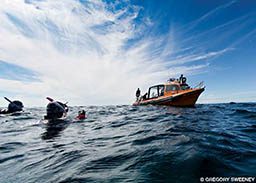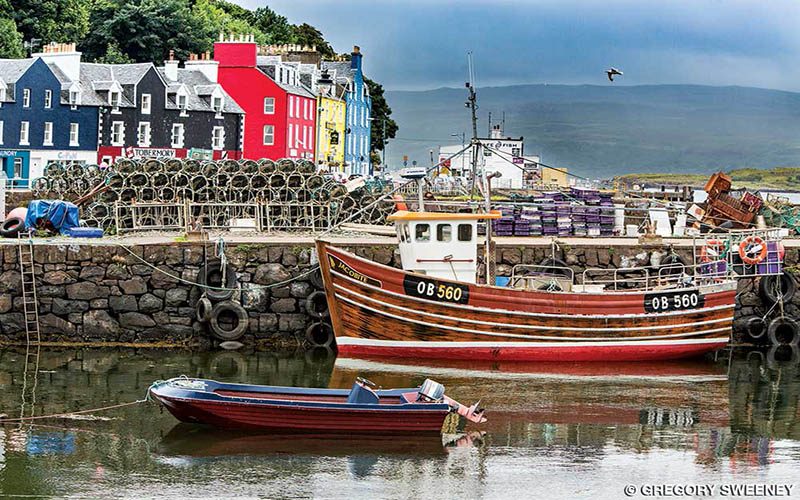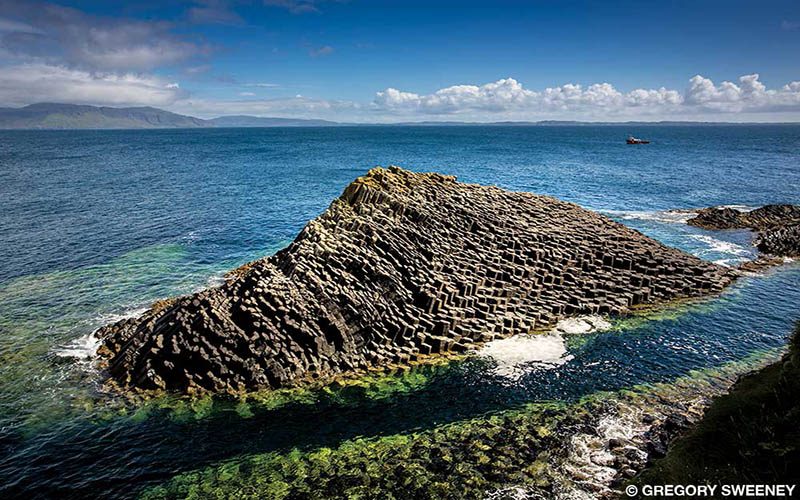Measuring up to 40 feet long, the basking shark (Cetorhinus maximus) is the world’s second-largest fish, smaller than only the whale shark. The last surviving member of the Cetorhinidae family, the basking shark belongs to the same order (Lamniformes) as the great white shark and at a distance is occasionally mistaken for its much smaller cousin. Unlike the predatory great white, however, the basking shark is one of only three plankton-eating sharks, along with the whale shark and the megamouth shark.
Basking sharks are easily recognizable by their large gaping mouths with gill slits that almost encircle their heads. The gill rakers, arranged along the gill arches, are specially adapted bones that passively strain plankton from the water in much the same way that filter-feeding whales use baleen. The basking shark gets its name from the way it feeds during warmer months at the plankton-rich surface of the ocean, with its exposed dorsal fin basking in the sun.
The basking shark’s brain is very small compared with those of predatory sharks, which must actively engage strategy to hunt prey. Its olfactory tract is larger than the rest of its brain, indicating how critical its sense of smell is to its survival, likely because it helps the shark to locate plankton.

In contrast to its undersized brain, the basking shark’s liver is comparatively large, comprising up to one-third of its total body weight. Basking shark livers are filled with squalene oil to provide both energy and buoyancy, the latter being necessary in the absence of a swim bladder. Unfortunately, the shark’s oil-rich liver also makes it attractive to poachers looking to capitalize on the predictable behaviors of these calm animals, who swim slowly and close to the surface.
Basking in Scotland
As a cosmopolitan migratory species, basking sharks can be found in all the world’s temperate oceans. I was lucky enough to encounter them off the coast of Scotland, which boasts some of the richest cold waters in the world. Every spring Scottish oceanic and weather cycles create optimal conditions for explosive blooms of plankton, drawing basking sharks from their winter feeding grounds to mate and feast on plankton. Because researchers have been following and documenting the population of basking sharks off the Scottish coastline for many years, the probability is high for good in-water encounters during peak season.
When I arrived, I learned that the best place to find the basking sharks was in a channel not far from our base on the Isle of Coll. Each morning crew members from a local boat tour company were going to take us to nearby passes with current in search of basking sharks working patches of food in the moving water. My first outing brought my first sighting, and I recall peering off the starboard side of our dive boat toward the enormous, ancient-looking basking shark casually feeding in the cold green water of Scotland’s Outer Hebrides islands. We were still within sight of land as I prepared to put on fins, slip into the water and share a few minutes with this gentle giant.

I’m no stranger to coldwater diving, but basking sharks feed near the surface, which makes drysuit diving impractical. We were to gear up two at a time and get in the water upstream of the basking sharks with our guide. Wearing a wetsuit, I knew the cold water was going to hurt; nonetheless, it had to be done. I splashed in, shouted some expletives and turned my attention to the life around me. The bottom was a canvas of green and purple kelp with orange starfishes, white sand, lobsters, fish and, of course, the main attraction itself. It was thrilling the first time I had a head-on composition in my viewfinder and saw the shark opening its mouth agape.
Basking sharks are often social, and we were lucky that our third day of diving was the best of the season for both weather and basking shark sightings. Calm conditions allowed the crew to deploy a drone over the channel, yielding views of several basking sharks working the surface. Excitedly, we entered the water upstream and were blown away when four sharks, one after another, came straight toward us.
After one of our dives, we trolled the area looking for more basking sharks and spotted some dorsal fins. To our surprise, one of the basking sharks flew into a full-body breach right near the rocks. Basking shark breaching is rare, difficult (considering their size and slowness) and poorly understood. One theory suggests that the behavior is part of mating, an activity that might be linked to this seasonal aggregation; a second theory posits that it may help the sharks rid themselves of parasitic fish such as lampreys. The only recorded incident of human death related to basking sharks in the United Kingdom occurred when a breaching shark landed on a boat, causing some of the passengers to drown.
Divers interested in encountering basking sharks may also be delighted by the broader ecosystem they inhabit, which in Scotland includes popular puffin nesting areas. My group and I took one afternoon away from basking sharks to visit the Isle of Lunga, where we trekked over a rocky shoreline to follow a path up a cliff. As the trail twisted upward, we could see a cloud of puffins riding the onshore wind to their destinations. With wings and feet spread, they landed on the grass-tufted cliff edge, where they would sit and gaze to the sea or disappear into a hole to check on their chicks. Since this was the end of the season, the chicks would soon find their parents had returned to sea, leaving them to fledge on their own.

Vulnerability
As with too many of the ocean’s remarkable creatures, basking sharks find themselves fighting for survival and have been listed as vulnerable on the International Union for Conservation of Nature and Natural Resources (IUCN) Red List of Threatened Species.
Historically, basking sharks have been a staple of fisheries because of their size, slow movement and (former) abundance. In Scotland, fishermen also culled basking sharks because they viewed them as a nuisance for becoming entangled in fishing line. Hunters all over the world continue to target basking sharks for their fins and the vast amounts of oil their livers produce. Even though many countries, including the United Kingdom, list basking sharks as a protected species, the fact that the sharks migrate from protected areas into other waters, such as those off the coast of China and Japan, puts them at risk.
Possible future threats include global warming, which has already shifted the range of the basking shark’s food supply northward, and microplastics, which are captured in the basking shark’s gill rakers as it feeds. The consequences of both developments on populations of basking sharks remains to be seen, but the shark’s long gestation and slow maturation mean that unnatural losses make species health unsustainable.
On our last afternoon with Scotland’s mysterious gentle giants, my companions and I explored between some shallow coves and low islands. Seals resting on the rocks watched us as we passed by. The area was full of basking sharks swimming in repeating sweeps between the islands. The water was choppier and less clear than before, but in the confined area the sharks seemed to be swimming more slowly but with purpose and directly toward us as they fed with open mouths. It was a frenzy of basking sharks of all sizes.
We stayed in the water for more than two hours, getting front-on videos and close side shots all without much swimming. One by one, we became tired and cold and finally had to exit the water. Leaving the water with a full memory card, it was a perfect finish. I hope that continued protections will allow future generations to experience these mysterious and fascinating creatures.
Explore More
| © Alert Diver — Q3 2018 |